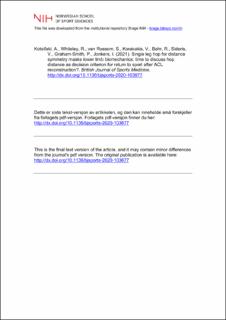| dc.contributor.author | Kotsifaki, Argyro | |
| dc.contributor.author | Whiteley, Rod | |
| dc.contributor.author | van Rossom, Sam | |
| dc.contributor.author | Korakakis, Vasileios | |
| dc.contributor.author | Bahr, Roald | |
| dc.contributor.author | Sideris, Vasileios | |
| dc.contributor.author | Graham-Smith, Philip | |
| dc.contributor.author | Jonkers, Ilse | |
| dc.date.accessioned | 2021-09-13T06:44:36Z | |
| dc.date.available | 2021-09-13T06:44:36Z | |
| dc.date.created | 2021-06-16T11:39:44Z | |
| dc.date.issued | 2021 | |
| dc.identifier.citation | British Journal of Sports Medicine. 2021. | en_US |
| dc.identifier.issn | 0306-3674 | |
| dc.identifier.uri | https://hdl.handle.net/11250/2775334 | |
| dc.description | Dette er siste tekst-versjon av artikkelen, og den kan inneholde små forskjeller fra forlagets pdf-versjon. Forlagets pdf-versjon finner du her: http://dx.doi.org/10.1136/bjsports-2020-103677 / This is the final text version of the article, and it may contain minor differences from the journal's pdf version. The original publication is available here: http://dx.doi.org/10.1136/bjsports-2020-103677 | en_US |
| dc.description.abstract | Background: We evaluated the lower limb status of athletes after anterior cruciate ligament reconstruction (ACLR) during the propulsion and landing phases of a single leg hop for distance (SLHD) task after they had been cleared to return to sport. We wanted to evaluate the biomechanical components of the involved (operated) and uninvolved legs of athletes with ACLR and compare these legs with those of uninjured athletes (controls). Methods: We captured standard video-based three-dimensional motion and electromyography (EMG) in 26 athletes after ACLR and 23 healthy controls during SLHD and calculated lower limb and trunk kinematics. We calculated lower limb joint moments and work using inverse dynamics and computed lower limb muscle forces using an EMG-constrained musculoskeletal modelling approach. Between-limb (within ACLR athletes) and between-group differences (between ACLR athletes and controls) were evaluated using paired and independent sample t-tests, respectively. Results: Significant differences in kinematics (effect sizes ranging from 0.42 to 1.56), moments (0.39 to 1.08), and joint work contribution (0.55 to 1.04) were seen between the involved and uninvolved legs, as well as between groups. Athletes after ACLR achieved a 97%±4% limb symmetry index in hop distance but the symmetry in work done by the knee during propulsion was only 69%. During landing, the involved knee absorbed less work than the uninvolved, while the uninvolved knee absorbed more work than the control group. Athletes after ACLR compensated for lower knee work with greater hip work contribution and by landing with more hip flexion, anterior pelvis tilt, and trunk flexion. Conclusion: Symmetry in performance on a SLHD test does not ensure symmetry in lower limb biomechanics. The distance hopped is a poor measure of knee function, and largely reflects hip and ankle function. Male athletes after ACLR selectively unload the involved limb but outperform controls on the uninvolved knee. | en_US |
| dc.language.iso | eng | en_US |
| dc.subject | acl | en_US |
| dc.subject | biomechanics | en_US |
| dc.subject | injury prevention | en_US |
| dc.subject | knee injuries | en_US |
| dc.subject | sporting injuries | en_US |
| dc.title | Single leg hop for distance symmetry masks lower limb biomechanics: time to discuss hop distance as decision criterion for return to sport after ACL reconstruction? | en_US |
| dc.type | Peer reviewed | en_US |
| dc.type | Journal article | en_US |
| dc.description.version | acceptedVersion | en_US |
| dc.source.pagenumber | 9 | en_US |
| dc.source.journal | British Journal of Sports Medicine | en_US |
| dc.identifier.doi | 10.1136/bjsports-2020-103677 | |
| dc.identifier.cristin | 1916097 | |
| dc.description.localcode | Insitutt for idrettsmedisinske fag / Department of Sports Medicine | en_US |
| cristin.ispublished | true | |
| cristin.fulltext | postprint | |
| cristin.qualitycode | 2 | |
